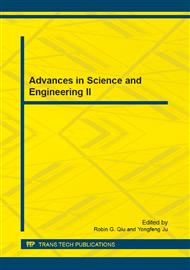[1]
Akyildiz, I. F, Xudong Wang. A Survey on Wireless Mesh Networks. Communications Magazine IEEE. Sept. 2005, Volume 43(Issue 9): s23~s30.
DOI: 10.1109/mcom.2005.1509968
Google Scholar
[2]
Ian F. Akyildiz, Xudong Wang, Weilin Wang. Wireless mesh networks: a survey. Computer Networks 2005(47): 445~487.
DOI: 10.1016/j.comnet.2004.12.001
Google Scholar
[3]
Rudolf Ahlswede, Ning Cai, Shuoyen Robert Li. Network Information Flow [J]. IEEE Transactions on Information Theory, 2000, 46(4). 1204-1216.
DOI: 10.1109/18.850663
Google Scholar
[4]
S.Y. Li, R.W. Yeung and N. Cai: Linear network coding[J]. IEEE Transactions on Information Theory, 2003, 371–381.
DOI: 10.1109/tit.2002.807285
Google Scholar
[5]
S. Katti, H. Rahul, W. Hu, ect. XORs in the air: Practical wireless network coding[C]. In. ACM SIGCOMM 2006, Pisa, Italy. 2006, 9. 243-254.
DOI: 10.1145/1151659.1159942
Google Scholar
[6]
C.T. Chou, A. Misra, J. Qadir, Low Latency Broadcast in Multi-Rate Wireless Mesh Networks[J], IEEE JSAC Special Issue on Multi-hop Wireless Mesh Networks, November 2006, Vol. 24(11).
DOI: 10.1109/jsac.2006.881621
Google Scholar
[7]
P. Chaporkar, A. Proutiere. Adaptive Network Coding and Scheduling for Maximizing Throughput in Wireless Networks[C]. In MOBICOM, (2007).
DOI: 10.1145/1287853.1287870
Google Scholar
[8]
L.F.M. Vieira, A. Misra, M. Gerla. Performance of Network Coding in Multi-Rate Wireless Environments for Multicast Applications[C]. In IEEE GLOBECOM, (2007).
DOI: 10.1109/milcom.2007.4454823
Google Scholar
[9]
H. Seferoglu, A. Markopoulou, U. Kozat. Network coding-aware rate control and scheduling in wireless networks[C]. In ICME, (2009).
DOI: 10.1109/icme.2009.5202787
Google Scholar
[10]
Omiwade. S, Zheng. R, Hua. C. Butterflies in the Mesh: Lightweight Localized Wireless Network Coding[C]. In: Proc. of Fourth Workshop on Network Coding, Theory, and Applications, (2008).
DOI: 10.1109/netcod.2008.4476174
Google Scholar
[11]
B. sadeghi, V. Kanodia, A. Sabharwal, E. Knightly. OAR: An opportunistic auto-rate media access protocol for ad hoc networks [J]. Wireless Networks, vol. 11, p.39–53, (2005).
DOI: 10.1007/s11276-004-4745-x
Google Scholar
[12]
The network simulator-ns2. http: /www. isi. edu/nsnam/ns.
Google Scholar


